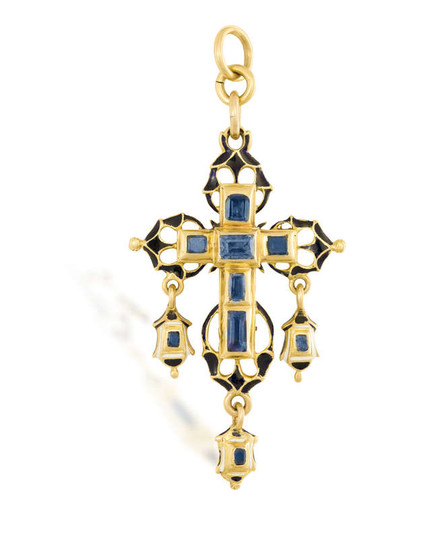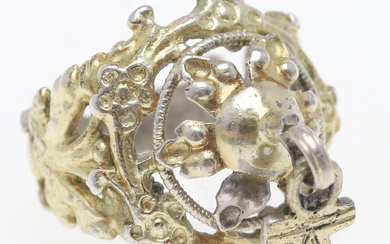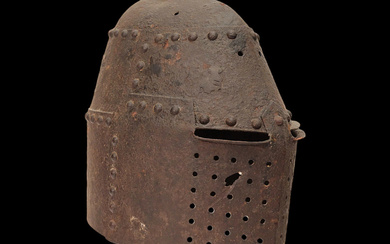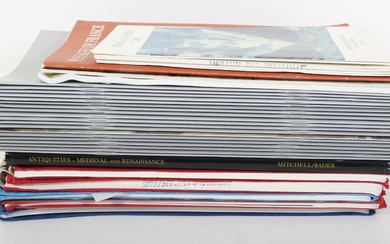Description A 19TH CENTURY 'MEDIEVAL REVIVAL' GEM-SET & ENAMEL...
Description
A 19TH CENTURY 'MEDIEVAL REVIVAL' GEM-SET & ENAMEL CROSS PENDANT, CIRCA 1845
The Latin cross set with table-cut green and blue stones, each terminal within an openwork enamelled border, three elements of similar style suspending from the arms and the feet of the cross, the reverse decorated with blue enamel throughout, mounted in gold, on late gold bale, length (excluding bale) 6.8cm, width 4.1cm
The design of this 19th century cross is characteristic of the Puy-en-Velay region of Auvergne, in France. The blue enamelled flames on the reverse act as a visual representation in the place of the human form of Christ. The four arms of the cross are formed as the letter m from uncial script, commonly used by Latin and Greek scribes from the 4th to 8th centuries AD. In the Middle ages this letter was used to represent Mary, the mother of Christ. Further symbolism of the crucifixion can be seen in the three hanging droplets depicting the Christs tears of pain.
It is evident in the design of this cross that the goldsmith is responding to styles of both the 15th and 16th centuries. There was a particular penchant for medieval aesthetic in the 19th century. This revivalism was reflected in the decorative and literary arts of the period, in 1831, Victor Hugo publishes Notre-Dame de Paris. The architect of historical monuments in France, Prosper Mérimée, charges Eugène Viollet-le-Duc to restore Mont Saint-Michel, the ramparts of Carcassonne. A renewed interest in the Medieval period, in particular a respect for the religious belief systems, resulted in objects such as the present lot which are imbued with a strong sense of ecclesiastical symbolism.
View it on
Sale price
Estimate
Time, Location
Auction House
Description
A 19TH CENTURY 'MEDIEVAL REVIVAL' GEM-SET & ENAMEL CROSS PENDANT, CIRCA 1845
The Latin cross set with table-cut green and blue stones, each terminal within an openwork enamelled border, three elements of similar style suspending from the arms and the feet of the cross, the reverse decorated with blue enamel throughout, mounted in gold, on late gold bale, length (excluding bale) 6.8cm, width 4.1cm
The design of this 19th century cross is characteristic of the Puy-en-Velay region of Auvergne, in France. The blue enamelled flames on the reverse act as a visual representation in the place of the human form of Christ. The four arms of the cross are formed as the letter m from uncial script, commonly used by Latin and Greek scribes from the 4th to 8th centuries AD. In the Middle ages this letter was used to represent Mary, the mother of Christ. Further symbolism of the crucifixion can be seen in the three hanging droplets depicting the Christs tears of pain.
It is evident in the design of this cross that the goldsmith is responding to styles of both the 15th and 16th centuries. There was a particular penchant for medieval aesthetic in the 19th century. This revivalism was reflected in the decorative and literary arts of the period, in 1831, Victor Hugo publishes Notre-Dame de Paris. The architect of historical monuments in France, Prosper Mérimée, charges Eugène Viollet-le-Duc to restore Mont Saint-Michel, the ramparts of Carcassonne. A renewed interest in the Medieval period, in particular a respect for the religious belief systems, resulted in objects such as the present lot which are imbued with a strong sense of ecclesiastical symbolism.







